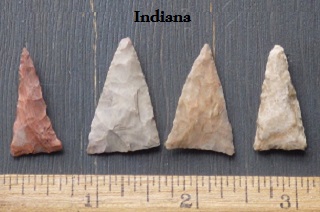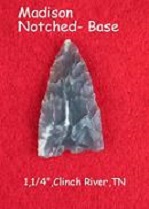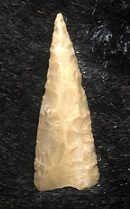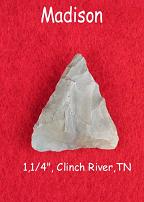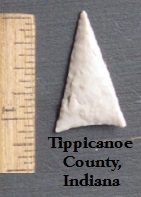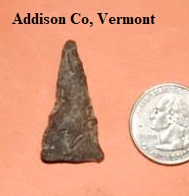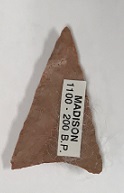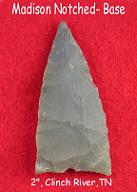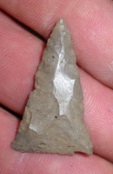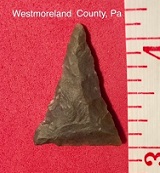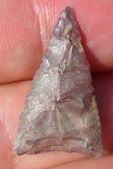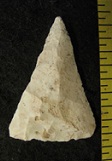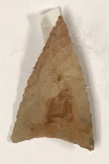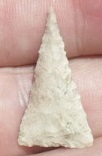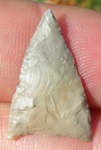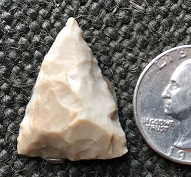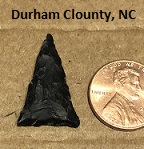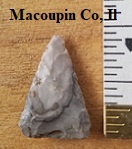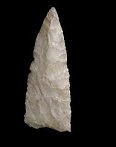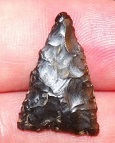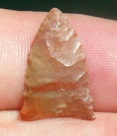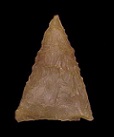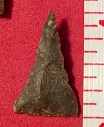Outline is Representative of Size and Shape:
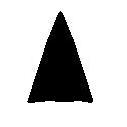
Name Details:
Identified By: Edward G Scully
Named For: County in Illinois
Date Identified: 1951
Type Site:
Identified By: Edward G Scully
Named For: County in Illinois
Date Identified: 1951
Type Site:
Point Validity:
Valid type
Scully is a highly respected anthropologist from the University of Michigan who conducted extensive research in the Mississippi River valley and identified many different types of projectile points. This type was named in a professional publication and has many professional references. This is considered a valid type.
Scully is a highly respected anthropologist from the University of Michigan who conducted extensive research in the Mississippi River valley and identified many different types of projectile points. This type was named in a professional publication and has many professional references. This is considered a valid type.
Madison Triangle
AKA: Mississippi Triangular (Scully 1951)Cluster: Late Woodland to Early Mississippian Triangle Cluster
Description of Physical Characteristics and Flaking Pattern:
This is a thin small (.5 to .75 inches) triangular point with a flattened cross section. The blade is primarily straight, but may be seen with an excurvate or even less frequently, an incurvate blade. Rarely, the blade may be serrated. The point primarily forms an isosceles triangle (half as wide as the height), or less frequently form an equilateral triangle (as wide as the height). The base is primarily straight to slightly concaved and commonly has basal thinning. The flaking pattern is random. This point is manufactured using pressure flaking and may range from high quality workmanship to very crude. Re-sharpening is not common with the exception of the tip.
Size Measurements:
Length - 13 to 55 mm (26 mm average), Width - 12 to 25 mm, Thickness - 3 to 6 mm
Length - 13 to 55 mm (26 mm average), Width - 12 to 25 mm, Thickness - 3 to 6 mm
Commonly Utilized Material:
Various local materials including cherts, quartz, rhyolite, and jasper. Heat treatment is commonly used especially on harder materials such as cherts.
Various local materials including cherts, quartz, rhyolite, and jasper. Heat treatment is commonly used especially on harder materials such as cherts.
Additional Comments:
This point is found over a wide distribution area, but the dates seem to change based on the geographic location. Small triangular points found in Florida and into southern Georgia are referred to as Pinellas points.
This point is thought to have replaced the Levanna point.
Scully first named this point Mississippi Triangular, but renamed it and popularized the new name. However, the name Mississippi Triangular or Late Mississippi Triangular was still used on older publication (Kneberg, 1956).
Morrow (2016), "Care should be taken not to mistake unfinished preforms for other small arrow points as finished Madison points. This can usually be done by carefully examining the degree of alignment or irregularity in the points/ preforms edges."
This point is found over a wide distribution area, but the dates seem to change based on the geographic location. Small triangular points found in Florida and into southern Georgia are referred to as Pinellas points.
This point is thought to have replaced the Levanna point.
Scully first named this point Mississippi Triangular, but renamed it and popularized the new name. However, the name Mississippi Triangular or Late Mississippi Triangular was still used on older publication (Kneberg, 1956).
Morrow (2016), "Care should be taken not to mistake unfinished preforms for other small arrow points as finished Madison points. This can usually be done by carefully examining the degree of alignment or irregularity in the points/ preforms edges."
Distribution: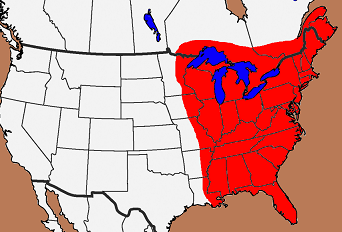

Distribution Comments:
This point is found from the Mississippi River to the the eastern seaboard. This point extends into southern Ontario, and may extend further into Canada.
This point is found from the Mississippi River to the the eastern seaboard. This point extends into southern Ontario, and may extend further into Canada.
Age / Periods:
Date: 1,100 - 300 B.P.
Cultural Period: Late Woodland to Mississippian
Glacial Period: Medieval Warm to Little Ice Age
Culture:
Date: 1,100 - 300 B.P.
Cultural Period: Late Woodland to Mississippian
Glacial Period: Medieval Warm to Little Ice Age
Culture:
Age Details:
Similar Points:
Camp Creek, Clements, Conestee, Hamilton Triangle, Fort Ancient, Fresno, Maud, Levanna, Pinellas, Sand Mountain, Tortugas, Uwharrie, Yadkin
Camp Creek, Clements, Conestee, Hamilton Triangle, Fort Ancient, Fresno, Maud, Levanna, Pinellas, Sand Mountain, Tortugas, Uwharrie, Yadkin
Other points in this cluster / Related / Associated Points:
Camp Creek, Clements, Conestee, Hamilton Triangle, Fort Ancient, Fresno, Maud, Levanna, Pinellas, Uwharrie, Yadkin
Camp Creek, Clements, Conestee, Hamilton Triangle, Fort Ancient, Fresno, Maud, Levanna, Pinellas, Uwharrie, Yadkin

